+ Open data
Open data
- Basic information
Basic information
| Entry | Database: PDB / ID: 2hvk | ||||||
|---|---|---|---|---|---|---|---|
| Title | crystal structure of the KcsA-Fab-TBA complex in high K+ | ||||||
 Components Components |
| ||||||
 Keywords Keywords | MEMBRANE PROTEIN / potassium channel / tetrabutylammonium / K+ / KcsA | ||||||
| Function / homology |  Function and homology information Function and homology informationaction potential / voltage-gated potassium channel activity / voltage-gated potassium channel complex / identical protein binding Similarity search - Function | ||||||
| Biological species |  Streptomyces lividans (bacteria) Streptomyces lividans (bacteria) | ||||||
| Method |  X-RAY DIFFRACTION / X-RAY DIFFRACTION /  SYNCHROTRON / SYNCHROTRON /  MOLECULAR REPLACEMENT / Resolution: 1.9 Å MOLECULAR REPLACEMENT / Resolution: 1.9 Å | ||||||
 Authors Authors | Zhou, Y. | ||||||
 Citation Citation |  Journal: J.Mol.Biol. / Year: 2007 Journal: J.Mol.Biol. / Year: 2007Title: Crystallographic Study of the Tetrabutylammonium Block to the KcsA K(+) Channel. Authors: Yohannan, S. / Hu, Y. / Zhou, Y. | ||||||
| History |
|
- Structure visualization
Structure visualization
| Structure viewer | Molecule:  Molmil Molmil Jmol/JSmol Jmol/JSmol |
|---|
- Downloads & links
Downloads & links
- Download
Download
| PDBx/mmCIF format |  2hvk.cif.gz 2hvk.cif.gz | 124.8 KB | Display |  PDBx/mmCIF format PDBx/mmCIF format |
|---|---|---|---|---|
| PDB format |  pdb2hvk.ent.gz pdb2hvk.ent.gz | 93 KB | Display |  PDB format PDB format |
| PDBx/mmJSON format |  2hvk.json.gz 2hvk.json.gz | Tree view |  PDBx/mmJSON format PDBx/mmJSON format | |
| Others |  Other downloads Other downloads |
-Validation report
| Summary document |  2hvk_validation.pdf.gz 2hvk_validation.pdf.gz | 769 KB | Display |  wwPDB validaton report wwPDB validaton report |
|---|---|---|---|---|
| Full document |  2hvk_full_validation.pdf.gz 2hvk_full_validation.pdf.gz | 778.8 KB | Display | |
| Data in XML |  2hvk_validation.xml.gz 2hvk_validation.xml.gz | 23.8 KB | Display | |
| Data in CIF |  2hvk_validation.cif.gz 2hvk_validation.cif.gz | 33.1 KB | Display | |
| Arichive directory |  https://data.pdbj.org/pub/pdb/validation_reports/hv/2hvk https://data.pdbj.org/pub/pdb/validation_reports/hv/2hvk ftp://data.pdbj.org/pub/pdb/validation_reports/hv/2hvk ftp://data.pdbj.org/pub/pdb/validation_reports/hv/2hvk | HTTPS FTP |
-Related structure data
| Related structure data |  2dwdC 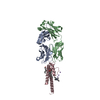 2dweC  2hvjC  1k4cS S: Starting model for refinement C: citing same article ( |
|---|---|
| Similar structure data |
- Links
Links
- Assembly
Assembly
| Deposited unit | 
| ||||||||||||||||||||||||
|---|---|---|---|---|---|---|---|---|---|---|---|---|---|---|---|---|---|---|---|---|---|---|---|---|---|
| 1 | 
| ||||||||||||||||||||||||
| Unit cell |
| ||||||||||||||||||||||||
| Components on special symmetry positions |
| ||||||||||||||||||||||||
| Details | Chain A and B assemble to form the biological unit of Fab. / Chain A and B assemble to form the biological unit Fab. / The biological assembly is a tetramer generated from the monomer in the asymmetric unit by the operations: -X,-Y,Z -Y,X,Z Y,-X,Z 1/2+X,1/2+Y,1/2+Z 1/2-X,1/2-Y,1/2+Z 1/2-Y,1/2+X,1/2+Z 1/2+Y,1/2-X,1/2+Z |
- Components
Components
-Protein , 1 types, 1 molecules C
| #3: Protein | Mass: 13211.582 Da / Num. of mol.: 1 / Mutation: P2A, L90C Source method: isolated from a genetically manipulated source Source: (gene. exp.)  Streptomyces lividans (bacteria) / Gene: kcsA, skc1 / Plasmid: pQE60 / Production host: Streptomyces lividans (bacteria) / Gene: kcsA, skc1 / Plasmid: pQE60 / Production host:  |
|---|
-Antibody , 2 types, 2 molecules AB
| #1: Antibody | Mass: 23411.242 Da / Num. of mol.: 1 / Source method: isolated from a natural source / Details: hybridoma cell line / Source: (natural)  |
|---|---|
| #2: Antibody | Mass: 23435.738 Da / Num. of mol.: 1 / Source method: isolated from a natural source / Details: hybridoma cell line / Source: (natural)  |
-Non-polymers , 5 types, 187 molecules 








| #4: Chemical | ChemComp-F09 / | ||||||
|---|---|---|---|---|---|---|---|
| #5: Chemical | ChemComp-K / #6: Chemical | ChemComp-L2C / ( | #7: Chemical | ChemComp-TBA / | #8: Water | ChemComp-HOH / | |
-Details
| Has protein modification | Y |
|---|
-Experimental details
-Experiment
| Experiment | Method:  X-RAY DIFFRACTION / Number of used crystals: 1 X-RAY DIFFRACTION / Number of used crystals: 1 |
|---|
- Sample preparation
Sample preparation
| Crystal | Density Matthews: 3.85 Å3/Da / Density % sol: 68.05 % |
|---|---|
| Crystal grow | Temperature: 293 K / Method: vapor diffusion / pH: 6.5 Details: 18-25% PEG 400, 50mM Mg(Ac)2, 50mM NaAc (pH5) or Na Cacodylate (pH6) or Hepes (PH 7), pH 6.5, VAPOR DIFFUSION, temperature 293K |
-Data collection
| Diffraction | Mean temperature: 100 K |
|---|---|
| Diffraction source | Source:  SYNCHROTRON / Site: SYNCHROTRON / Site:  NSLS NSLS  / Beamline: X29A / Wavelength: 1.1 Å / Beamline: X29A / Wavelength: 1.1 Å |
| Detector | Type: ADSC QUANTUM 315 / Detector: CCD / Date: May 7, 2006 / Details: mirrors |
| Radiation | Monochromator: Si 111 / Protocol: SINGLE WAVELENGTH / Monochromatic (M) / Laue (L): M / Scattering type: x-ray |
| Radiation wavelength | Wavelength: 1.1 Å / Relative weight: 1 |
| Reflection | Resolution: 1.9→30 Å / Num. all: 71937 / Num. obs: 71466 / % possible obs: 99.2 % / Observed criterion σ(F): 0 / Observed criterion σ(I): 0 / Redundancy: 6.5 % / Rmerge(I) obs: 0.058 / Χ2: 1.113 / Net I/σ(I): 16.7 |
| Reflection shell | Resolution: 1.9→1.97 Å / Redundancy: 4.1 % / Rmerge(I) obs: 0.413 / Num. unique all: 6654 / Χ2: 0.927 / % possible all: 92.8 |
- Processing
Processing
| Software |
| ||||||||||||||||||||||||||||
|---|---|---|---|---|---|---|---|---|---|---|---|---|---|---|---|---|---|---|---|---|---|---|---|---|---|---|---|---|---|
| Refinement | Method to determine structure:  MOLECULAR REPLACEMENT MOLECULAR REPLACEMENTStarting model: PDB entry 1K4C Resolution: 1.9→27 Å / σ(F): 0 / Stereochemistry target values: Engh & Huber
| ||||||||||||||||||||||||||||
| Solvent computation | Bsol: 41.126 Å2 | ||||||||||||||||||||||||||||
| Displacement parameters | Biso mean: 37.515 Å2
| ||||||||||||||||||||||||||||
| Refinement step | Cycle: LAST / Resolution: 1.9→27 Å
| ||||||||||||||||||||||||||||
| Refine LS restraints |
| ||||||||||||||||||||||||||||
| Xplor file |
|
 Movie
Movie Controller
Controller




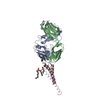





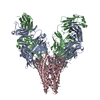






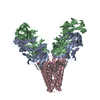

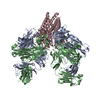



 PDBj
PDBj







